April 17, 2009
Air Date: April 17, 2009
FULL SHOW
SEGMENTS
Pesticides and Birth Defects
View the page for this story
In the spring and early summer, levels of pesticides in water increase. One weed killer in particular, Atrazine, shows up in surprisingly high amounts. Host Steve Curwood talks with Dr. Paul Winchester to learn why babies conceived between April and July may be more likely to develop birth defects. (06:30)
Prioritizing Climate Solutions
View the page for this story
The nation's most influential energy and climate change policy makers gathered at MIT to set goals for the future. The challenges are daunting and the dangers are real. President Obama's climate czar, Carol Browner, and chief science advisor, John Holdren, attended the MIT summit. (06:00)
Replacing Wall Street
View the page for this story
Author David Korten has a vision for a world run not by financial speculation but by "real" wealth-- anything that contributes to a healthy planet and happy communities. He talks with host Steve Curwood about how Wall Street creates and controls wealth. His new book is "Agenda for a New Economy: From Phantom Wealth to Real Wealth." (06:10)
Kicking out the Crows
/ Sy MontgomeryView the page for this story
In celebration of Earth Month, Living on Earth is revisiting some of our favorite stories. This week we go back to 2006 in Auburn, New York. Producer Sy Montgomery visited the town which each winter was invaded by hundreds of thousands of crows. No one knew exactly why the birds came but the scene they created – and the mess – had residents divided over whether to embrace the crows or drive them out. We’ll hear an excerpt from Sy’s piece and then host Jeff Young talks with Auburn Superintendent of Public Works, Jerry Delfavero, to find out whether the crows are still a problem. (11:20)
Note on Emerging Science
/ Lindsay BreslauView the page for this story
Scientists hope playing back recorded howls will help them keep track of wolves. Lindsay Breslau reports. ()
True Stories from the North Pole
View the page for this story
This month marks 100 years since Robert Peary became the first person to reach the North Pole...or was he? Host Jeff Young talks with Harvard Professor S. Alan Counter who's investigated Peary's journey. Counter says the trip to the pole is just the tip of the iceberg. The rest of Peary's story includes an overlooked African-American explorer, who played a crucial role on the journey and Inuit children the explorers fathered and then left behind. (08:00)
Sound Activism
View the page for this story
A musical tribute to Earth Day. (07:00)
Show Credits and Funders
Show Transcript
HOSTS: Steve Curwood and Jeff Young
GUESTS: Allen Counter, Jerry DelFavero, David Korten, Paul Winchester
REPORTER: Sy Montgomery
NOTE: Lindsay Breslau
[THEME]
CURWOOD: From Public Radio International - this is Living on Earth.
[THEME]
CURWOOD: I’m Steve Curwood.
YOUNG: And I’m Jeff Young.
Women who conceive between April and July may run more risk of having babies with birth defects.
WINCHESTER: That time period coincides quite well with the time period when surface waters measured across the U.S. are having significantly more pesticides in their concentration than any other time of year.
YOUNG: New research on pesticides and reproduction.
CURWOOD: And, a century after Robert Peary reached the North Pole we’re still learning about the forgotten Arctic explorers.
COUNTER: One general said he wasn't sure Peary made it to the North Pole because all he had for proof was an ignorant Negro and some ignorant Inuit people. They were called non-credible witnesses.
CURWOOD: Racism and the race to the top of the world.
These stories - and more - this week on Living on Earth! Stick around.
[NEWSBREAK MUSIC: Boards Of Canada “Zoetrope” from “In A Beautiful Place Out In The Country” (Warp Records 2000)]
ANNOUNCER: Support for Living on Earth comes from the National Science Foundation and Stonyfield Farm.
[THEME]
Pesticides and Birth Defects

CURWOOD: From the Jennifer and Ted Stanley Studios in Somerville, Massachusetts - this is Living on Earth. I’m Steve Curwood.
YOUNG: And I’m Jeff Young in Washington.
When crops go in the ground and start to grow, it’s the time for conventional farmers to apply chemical weed killers.
For example, millions of pounds of Atrazine are applied on US farms each year, even though the herbicide is banned in Europe.
And it should not be surprising that between April and July, there tend to be higher levels of pesticides in water than during the rest of the year, as the U.S. Geological Survey has found.
CURWOOD: What is surprising is new research that shows an association between the time of conception, pesticide levels, and the likelihood of crippling or fatal birth defects.
The research is being led by Paul Winchester, a neonatologist. His curiosity was aroused when he encountered a high level of birth defects when he began working in the heart of farm country at St. Francis Hospital in Indianapolis.
Dr. Winchester, what exactly did you find?
WINCHESTER: We found that birth defects like spina bifida, cleft pallet and lip, down syndrome, urogenital abnormalities, club foot among others are some of the birth defects that are more likely to occur for women who conceive between April and July. That time period coincides quite well with the time period when surface waters measured across the U.S. are having significantly more pesticides in their concentration than any other times of year.
CURWOOD: As a neonatologist, you must be seeing some of these children who have quite extensive urogenital defects. How true is that of your practice?
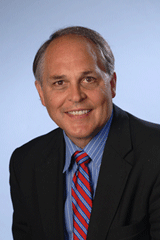
Dr. Paul Winchester.
CURWOOD: And how much of that are you seeing?
WINCHESTER: Well we do see a lot of it. Probably the most striking things that’s happened to us this last month, which is the month when babies conceived in June are delivering is that it seems that we have seen kind of one of everything. We’ve seen in a small hospital, community hospital setting, we’ve seen major birth defects that range from chromosome anomalies, spina bifida, adactyly, cleft pallet and lip – we’re just struck by the fact that this research appears to be right on, this month.
CURWOOD: How much did this research cost you and how did you pay for it?
WINCHESTER: Well we’re a non-funded research program. I kinda grew up on a farm in Montana where when you see the fences broke you just grab a fence post and a pair of pliers and go and fix it. And you hope that if you’re over there the neighbors will notice and give you a hand. And pretty much that’s how this research has been done. And I sometimes wonder if I had been funded whether this question would have been asked.
CURWOOD: Which question is that?
WINCHESTER: That is the number one cause of infant deaths turns out to have a higher risk occurrence in women who conceive between April and July. I kind of wonder why that’s news. And so, in a sense, we like to ask this large question, because we now know some things in rats and amphibians and alligators that these pesticides are in fact changing them because of fetal exposure. And we don’t have enough time to sort this out before perhaps we could have harmed generations of children.
CURWOOD: Now you say we need to look at the down stream effects of pesticide exposure – what do you mean exactly by that?
WINCHESTER: Probably one of the most important investigators in this area is a man named Michael Skinner who has shown us that the capacity that pesticides have to alter our lives has been grossly underestimated. In his model a pregnant rat is exposed for just a brief period in the very first phase of pregnancy to one pesticide. Keep in mind that there are no children in America who are exposed to just one pesticide. The average child is exposed to 300 chemicals at the time of conception. But in his model with just one pesticide all the rat babies when they were born did not have any birth defects at all. They looked perfectly normal. That’s really important to think about because had the experiment ended there, it would have been declared a safe exposure, not associated with any harm. As he likes to point out, thanks to some inquiring minds he was allowed to keep his experiment going long enough to see how these rats turned out as adults. And there he found that ninety percent of the males were afflicted by a whole host of disorders that we would refer to as adult disorders, adult diseases. They included conditions like low sperm count and infertility, immune disorders, kidney and prostate problems, cancer, high cholesterol and a shortened life span. And if that sounds bad, it’s really not as bad as the rest of the experiment. Because the rest of the experiment showed that this condition could be transferred to all subsequent generations without any further exposure. So if one pesticide could do this, imagine what might be happening in our society.
CURWOOD: What do you tell your patients, people who are thinking about having children, what about conceiving during the beginning of the growing season, this April to July period that seems to increase the risk of birth defects?
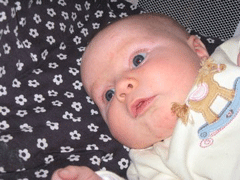
CURWOOD: Dr. Paul Winchester is a neonatologist at St. Francis Hospital in Indianapolis. Thank you so much, sir
WINCHESTER: Thank you.
[MUSIC: Pacifika “Sol” from Traveler ’08 (Six Degrees records 2008)]
Prioritizing Climate Solutions
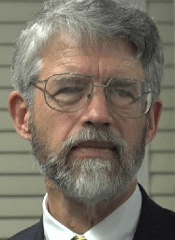
John Holdren is Science Advisor to the President.
YOUNG: Here in Washington the Obama administration has just made a major decision on global warming. The Environmental Protection Agency will use the Clean Air Act to regulate greenhouse gases. It’s the first time the federal government has set limits on carbon dioxide emissions.
The decision means EPA will begin a rule-making process that could lead to curbs on the CO2 coming from some sources like vehicles and power plants. EPA’s decision satisfies the requirements of a major Supreme Court ruling on greenhouse gases. And it will put pressure on Congress to enact a broader system to address climate change.
CURWOOD: And here in Massachusetts, Obama’s top energy and science advisers came to visit to one of the country’s leading science institutions: MIT in Cambridge. It’s part of a bid to get America rolling on developing innovative technologies as well policies to combat climate disruption.
With $150 billion to spend on scientific discovery and technological innovation over the next decade, the race is already on to turn this federal funding into employment and equipment. Carol Browner, assistant to the President for Energy and Climate Change, gave the keynote address in an auditorium overflowing with engineers, researchers and business developers.
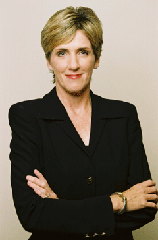
Carol Browner.
CURWOOD: But if America wants to lead this century, Carol Browner says, we’re first going to have pull ourselves out of the last one.
BROWNER: In the late nineteenth when Thomas Edison opened the Pearl St. power plant in Manhattan he pioneered an electricity delivery system that gave American industry what they needed to lead the world. Sadly if Edison were alive today he’d be all too familiar with the current system we rely on. Not that much has changed. I think we can all agree that we can do better than we did in 1882.
CURWOOD: In fact, many other nations are already doing better.
BROWNER: Europe and Asia have taken the lead in solar energy. In Germany wind power now supplies three percent of its total electricity production; Spain wind accounts for eleven percent; and in Denmark, nineteen percent - here, less than one percent, placing us just ahead of China and behind India.
CURWOOD: For John Holdren, Assistant to the President for Science and Technology, the event was something of a homecoming. The presidential science advisor began his training at MIT as a rocket scientist back in the early sixties after he was inspired by President Kennedy’s call to go to the Moon.
John Holdren compared that effort to the present task of changing our energy systems sufficiently and quickly enough to avert looming climate disaster.
HOLDREN: The energy challenge we face is actually a more difficult challenge than putting a man on the moon was and its more difficult in a variety of respects - we have to do things that pervade our whole economy, not just this country but around the world in order to get it done to the degree that is required. So it will take more than an Apollo program, more than a Manhattan project that produced the first nuclear weapons to get this done but we certainly have in this institution, in this country, and around the world, the talent that we need.
CURWOOD: To get emissions down to a level where he says there would be at least a 50-50 chance of avoiding climate catastrophe, John Holdren said the worldwide goal is to stop emitting the equivalent of nine billion tons of CO2 a year.
How to get there? He cited several options, each good for about one gigaton—that is a billion tons.
HOLDREN: We would have to cut energy use in all the world's buildings 20- 25% below business as usual.
Two billion cars would need to get 60 mpg rather than 30 to get one gigaton of carbon per year. 700 nuclear power plants would need to replace coal burning power plants to get one gigaton. A million two-megawatt wind turbines would need to replace coal burning power plants to get one gigaton of carbon per year. The 2005 rate of tropical deforestation would have to be cut in half approximately to get a gigaton.

John Holdren.
HOLDREN: Mitigation, meaning the things we can do to reduce the pace and magnitude of the changes in global climate that we are causing. Adaptation, meaning measures that we take to reduce the adverse impacts on human well being that result from the changes in climate that do occur. And the third option - we have to be frank about it - is suffering the adverse impacts that we fail to avoid by either mitigation or adaptation.
CURWOOD: Presidential science advisor John Holdren, speaking at MIT in Cambridge, Massachusetts.
[MUSIC: Horacio “El Negro” Hernandez/Robbie Ameen “Hit This, Split This (Producer Mix)” from El Negro And Robbie At The Third World War (American Clave 2004)]
[SOUND OF CROWS]
YOUNG: Just ahead – three years ago, the town of Auburn, New York was inundated with 30,000 crows. But with perseverance, the town sent the birds on the wing.
DELFAVERO: I mean we were getting calls all the time. “What are we going to do about this?” “I can’t get down my sidewalk.” “My car’s covered with it. You gonna pay for washing it.” It was like a constant barrage of calls. Now it’s a handful of year. And that’s because you might have a 100 crows in one tree near a residential area or whatever.
YOUNG: Find out how they did it. Keep listening to Living on Earth!
Related links:
- To learn more about John Holdren, click here
- Listen to a 2006 Living on Earth interview with Carol Browner
[CUTAWAY MUSIC: John Stetch “The Waltons” from TV Trio (Brux Records 2009)]
Replacing Wall Street

YOUNG: It’s Living on Earth, I’m Jeff Young.
CURWOOD: And I’m Steve Curwood.
The recession has meant a lot of things for a lot of people--lost jobs, lost investments, lost houses, lost sleep.
And for author David Korten, our current economic mess may also generate public support for fundamental changes in our economic system. His new book is called, "Agenda for a New Economy: From Phantom Wealth to Real Wealth: Why Wall Street Can’t Be Fixed and How to Replace it."
David Korten, what is the difference between what you call real and phantom wealth?
KORTEN: Phantom wealth is basically money that is created out of nothing. And Wall Street has become a master at phantom wealth creation.
CURWOOD: For example?
KORTEN: Well, pumping up financial bubbles. Of course, the whole mortgage debacle was based on the assumption that housing prices would rise forever and, of course, housing prices were rising even though there was no change in the size of the home and its state of repair, its livability, its location or anything else. It was pure inflation. But we treated that as though inflating housing prices was actually creating real wealth.
CURWOOD: And what is real wealth?
KORTEN: Well real wealth is anything of real value or utility. It can be land, labor, education, ideas. And at the most basic level it’s healthy children, it’s a strong family, it’s a healthy natural environment. The most valuable of real wealth is living wealth. But of course that does not come in in any way in the statistics by which we normally evaluate economic performance.
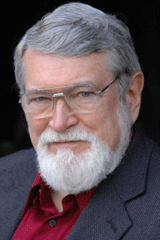
Author David Korten.
KORTEN: Yes, in our current system the creation of money is controlled by private banks. And it’s created when a bank issues a loan. It records the loan as a liability and makes another entry as an asset, which represents the money you need to repay. And with those simple entries, new money is created. Now the catch is that the bank creates only the amount of the principle, but you have to repay the principle plus interest, which means that in the aggregate, if the economy is not growing fast enough to generate enough demand for new loans to create the money to repay the interest, then the whole system goes into default, which is very much what has happened.
CURWOOD: So, wait a second, you’re saying that our banking system is essentially a Ponzi scheme.
KORTEN: It is very much a Ponzi scheme. And it’s a very sophisticated Ponzi scheme, but it puts the whole society into a condition of dependence and debt slavery such that we all end up working for the banks in the end.
CURWOOD: Now the folks who talk about a free market often cite Adam Smith. In your book, you also turn to Adam Smith. Seems that you and the folks that you don’t agree with are citing the same guru.
KORTEN: We are. And it’s interesting how, you know, many of our historic thought leaders have been distorted. Now, if one really understands Adam Smith – he was actually praising a market that looks very much like a local farmers market: a place where small producers and consumers come together in the context of a community and community values to exchange goods and services. Now what his writing has been used to justify is the consolidation and monopolization of economic power and, in fact, those who study Adam Smith’s work in depth conclude that he actually wrote “Wealth of Nations” as almost a tirade against the concentration and abuse of corporate power with the support of the state.
CURWOOD: How does the climate change crisis play into your thesis here?
KORTEN: What we need to face up to is that as a species we are exceedingly over consuming beyond what the planet can sustain. Now, we’re often told that any change in our consumption level will require sacrifice. There are enormous opportunities to at once reduce our consumption and increase our quality of life. But it requires an enormous reallocation of resources from those uses that are harmful, like warfare is an obvious example or the creation of an auto-dependent society, to a focus on meeting real needs and meeting the real needs of all people. Now, this requires almost literally standing our economy on its head to focus on life needs rather than on increasing the financial assets of the already very wealthy.
CURWOOD: Please describe for me, David Korten, the way a healthy economy from your perspective would operate, one that would in fact protect the environment and support our society. In other words, what should we replace Wall Street with?

CURWOOD: David Korten is president and founder of the People-Centered Development Forum, and author of "Agenda for a New Economy: From Phantom Wealth to Real Wealth, Why Wall Street Can't Be Fixed and How to Replace It."
Related link:
To visit David Korten’s website, click here.
[MUSIC: Various Artists “Goodbye Colonel (from A Few Dollars More – Shrift Remix)” from Cinematic: Classic Film Music Remixed (Six Degrees Music 2007)]
Kicking out the Crows

YOUNG: In honor of Earth Day, we’ve been digging into the Living on Earth archives for some favorite stories and catching up on new developments.
[SOUND OF CROWS]
YOUNG: Today we revisit a rather ominous report from 2006, one that could have come from a Hitchcock classic.
LATTIMORE: They're so thick; it's almost like out of the movie "The Birds."
YOUNG: For citizens of Auburn, New York, the invasion of crows is not Hollywood fiction – each winter it's been daily reality.
LATTIMORE: It's a gigantic black explosion – the noise, the beauty of the whole thing, it was beautiful. If that was on television I'd watch it. I'd love that.
YOUNG: When producer Sy Montgomery visited Auburn to report on a city inundated with crows, she found residents divided over whether the birds were a blessing or a curse.
MONTGOMERY: Auburn is a small city. A city of fine old churches and pretty little parks located about 25 miles southwest of Syracuse, as the crow flies. And each winter, a lot of crows do fly to this community of 28,000 people. Tens of thousands of them.
[CROW SOUNDS]
MONTGOMERY: The spectacle begins around dusk: a river of black wings, the air alive with noisy, hurrying birds flowing down from the sky. No one knows exactly why crows mass in the winter. Ornithologists think they do it to share information, or ward off predators with sheer numbers. Whatever the reason, crows have been roosting in Auburn for at least 100 years. They used to keep to the outskirts, but lately they've been coming downtown. Maybe it's the fine dining.
LATTIMORE: They know our trash routes better than our sanitation department!
MONTGOMERY: That's Auburn's Mayor, Tim Lattimore. When he took office, downtown Auburn's crow roost was the biggest in the state. Last winter, biologists counted 63,000 of them. In Auburn, in winter, crows are the talk of the town. Some folks welcome them; others are intimidated by so many black birds. But on one point, most agree: tens of thousands of crows can leave your city in, well, deep doo-doo.
LATTIMORE: I mean there are some businesses that we have here in town, such as the bank, the girls would have to leave and wear their umbrellas. Our local YMCA, when the people came out at night, they would normally get hit two or three times.
MONTGOMERY: Though experts assure the birds pose no threat of transmitting, say, bird flu, the crows do present the mayor with a big public relations problem.
LATTIMORE: I'm trying to attract Fortune 500 companies, and with the droppings that the birds were giving, I mean people would walk in City Hall with fecal matter on their feet. It's just not cleanly. It just doesn't give the right presentation that we want to give off here in the city of Auburn.
MONTGOMERY: So he called in the U.S. Department of Agriculture's Wildlife Services Program. Biologist Rich Chipman is the New York state director.
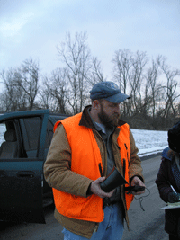
USDA biologist Rich Chipman prepares to go out with teams for crow harassment.(Photo: Rachel Gotbaum)
MONTGOMERY: For a week, Chipman and eight federal scientists team up with eight city employees, including Dave "Spider" Ganey, who's been working Auburn's streets for 35 years.
CHAPMAN: [ON CELL PHONE] Here, let me give you to Spider.
GANEY: VanAnden Street? Give us about two minutes. We're about two minutes away from there.
MONTGOMERY: Wearing blaze orange vests and driving trucks boldly labeled USDA Wildlife Services, these men are on a mission: to drive as many crows out of town as they can.
[TRAVEL SOUNDS]
MONTGOMERY: Tonight, we head for one of the birds' favorite spots, a neighborhood of tall pines and oaks, not far from a ball field.
CHIPMAN: This is prime time, about 6 o’clock, when we would certainly expect to see crows trying to roost here for the night.
MONTGOMERY: The team's arsenal is completely non-lethal, but effective:
[CROW DISTRESS CALL]
MONTGOMERY: A tape recording of a crow distress call broadcasts the news that this is no place to spend the night. Shining a bright red laser into the trees makes the crows nervous. Pretty soon, the flock gets the message:
[SOUNDS OF FLYING AND WINGS WITH RECORDED DISTRESS CALL IN BACKGROUND]
MONTGOMERY: As thousands of crows flee the trees, their wing beats sound like a rainstorm, and their deep black forms against the gray sky look like night itself taking flight.
[SOUNDS OF FLYING AND WINGS WITH RECORDED DISTRESS CALL IN BACKGROUND]
[SOUND OF DOG BARKING]
MONTGOMERY: Each night, teams try to hit all the crow hotspots, like a little park on the west side of town.
CHIPMAN: Here, along the back of the bench, you can see whitewash. This is all crow dropping in here, it's really impacted people's ability to enjoy the area.
GANEY: I work for the city, so I see it all the time. The parking meters were so bad you couldn't even put money in them, they'd be dripping with this.
MONTGOMERY: But in the grove of trees where the birds typically roost, we find none tonight. This is the fifth night of the program, and these extremely intelligent birds are learning fast. If they don't leave things will only get worse.
GANEY: Do you have your artillery rounds, Rich? I've got some caps left.
[SOUND OF CAPS AND GETTING OUT CAR.]
[SOUNDS OF GETTING PYRO READY FOR A FEW SECONDS IN TRUCK]
MONTGOMERY: For stubborn crows, Chipman and Spider break out the heavy stuff.
[PYRO SHOOTS OFF]
MONTGOMERY: Screaming rockets shot off from a cap gun zigzag into the night air.
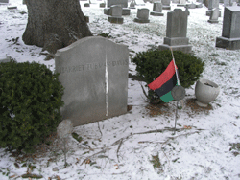
Crow droppings mar the gravestone of Underground Railroad heroine Harriet Tubman. (Photo: Sy Montgomery)
[MORE PYRO SOUNDS]
MONTGOMERY: Near the maximum-security prison, usually a favored spot, one lone crow eyes the USDA truck suspiciously from the top of a tall tree.
CHIPMAN: Quite often before they roost they'll send in a sentinel or a scout to make sure things are OK, and you can see this guy that just came in here, and he’s looking around, and he's obviously a little nervous. See how he's sort of bobbing back and forth? He may go back and send a message that this isn't the place to go for tonight. They actually communicate back and forth quite a bit.
MONTGOMERY: Word's apparently spreading in Crowdom. So far, 90 percent of the 36,000 crows that showed up this year are gone. After seven days and 14,000 city dollars, downtown Auburn is no longer crow city.
YOUNG: Reporter Sy Montgomery telling us about the crows of New York in that story in 2006. And with us on the phone now to give us the update is the city of Auburn’s superintendent of public works, Jerry DelFavero. Hi Mr. DelFavero?
DELFAVERO: Hi, how are you?
YOUNG: I’m doing well. Thanks for joining us. When Sy Montgomery told us about this just three years ago you had more than 30,000 crows. How many this year?
DELFAVERO: We’re down to thousands. I mean it’s a manageable flock. I mean, you wouldn’t even know it’s a problem in Auburn anymore.
YOUNG: And remind us you’re doing what – this scare crows and tying a pie tin on the top of a tree – it’s a little more sophisticated than that.

Mayor Tim Lattimore has paid the USDA to scare crows from the city. (Photo: Rachel Gotbaum)
YOUNG: It sounds like this costs a lot of money though.
DELFAVERO: Actually, when we were going to contract with the USDA it was a pretty big amount but it was worth it even at that. But now with us doing it, we purchase our own equipment, we probably got around $2500 worth of equipment purchased. And with our labor, it’s – the guys have gotta be here anyways – we’re using them for an eight hour day, and six to eight guys out of seventy employees that we have at the public works. So it really isn’t that costly for us at this time, you know, with us doing it ourselves. It’s working very well.
YOUNG: And I guess you’ve got to be saving some money in terms of the – you don’t have as much crow excrement to deal with.
DELFAVERO: Well, I can tell you right now that in the last few years we’ve had a handful of crow complaints. I mean, ten, twelve years ago, eight years ago, seven years ago – I mean it was constant daily. It was – I mean, we were getting calls all the time. “What are we going to do about this?” “I can’t get down my sidewalk.” “My car’s covered with it. You gonna pay for washing it?” It was like a constant barrage of calls. Now that’s a handful of year. And that’s because you might have a 100 crows in one tree near a residential area or whatever.

DELFAVERO: Well, you know what, we still got salt and snow and dirt
[LAUGHING]
DELFAVERO: So, you know, I mean, you still gotta wash your car – you know, fortunately or unfortunately however you wanna look at it. You don’t have those big white globs all over everything. So I’m glad it’s happening and no crows are being hurt. Unfortunately, I get calls from other surrounding towns and cities wantin’ to know why I sent the birds over to them or whatever.
YOUNG: And where do they go?
DELFAVERO: You know on the outskirts. There’s a lot of rural areas outside of Auburn and hopefully that’s where they’re going. I really can’t pin point, you know. We don’t take the birds or whatever. But you know, it is working and if they’re going back out to the country and into the cornfields, that’s great.
YOUNG: You know this might seem like a strange question for someone who’s devoted so much time to chasing these birds away, but I’m wondering – do you miss them a little bit because …
DELFAVERO: Oh sure, sure.
YOUNG: … it was kind of a phenomenon.
DELFAVERO: Well, let me tell you – and, you know, I’ve been with the city for over thirty years. I mean, just going down, we have an arterial that goes through the town, just going down, if we were down visiting the mall with my family or whatever, the first thing you would do at six o’clock during the winter months is look up to the sky and be amazed at how many crows were there. It was quite a sight to see – I mean, if you’ve never seen if, you would be shocked. If you were driving through town, you’d probably pull over just to watch that event. It was quite an amazing, amazing sight to see such a flock coming in and going out of Auburn.
YOUNG: Jerry DelFavero is superintendent of the public works department for the city of Auburn in New York talking to us about dealing with far too many crows. Thanks very much for your time. I appreciate it.
DELFAVERO: Okay, thank you. Yup. Bye.
[MUSIC: Joni Mitchell “Black Crow” from Hejira (Asylum Records 1976)]
YOUNG: Just ahead – notes to celebrate Earth Day – and its 39h birthday. Stay with us - on Living on Earth.
ANNOUNCER: Support for the Environmental Health Desk at Living on Earth comes from the Cedar Tree Foundation. Support also comes from the Richard and Rhoda Goldman fund for coverage of population and the environment. And from Gilman Ordway for coverage of conservation and environmental change. This is Living on Earth on PRI, Public Radio International.
[CUTAWAY MUSIC: Chico Hamilton “Nonchalant” from Twelve Tones Of Love (Joyous Shout 2009)]
Note on Emerging Science

YOUNG: It’s Living on Earth. I’m Jeff Young.
CURWOOD: And I’m Steve Curwood.
Coming up: the rest of the story behind the 1909 North Pole Expedition. But first this Note on Emerging Science from Lindsay Breslau.
[WOLF SOUNDS]
BRESLAU: Haunting and beautiful, a wolf's cry pierces the darkness of a Montana night. The wolf believes it's answering a call from a fellow Canis lupus, but it’s been hoodwinked. The "call of the wild" it replies to is a recording played by a small box on a nearby tree.
[MUSIC]
BRESLAU: The Howlbox runs on solar power and plays a recorded howl twice a day, at dawn and dusk. As soon as it emits a cry, the box switches into record mode to capture any responses. It then goes into "sleep" mode until the next programmed recording.
The gray wolf of the northern Rocky Mountains was removed from the endangered species list in March, and it is now up to the states to keep tabs on the wolves, as well as fund the project. The Howlbox is cheaper and less invasive than traditional tracking methods like radio collars and aerial monitoring. It's one of several new inventions by the University of Montana, the Nez Perce tribe, and other organizations, to reduce the cost of tracking.
University researchers will continue to test the Howlbox this summer on a large wolf population in Idaho. They hope the call and response device will be a howling success and make tracking easier, especially in isolated areas.
That's this week's note on emerging science. I'm Lindsay Breslau.
True Stories from the North Pole
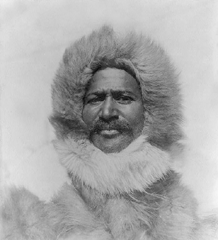
Matthew Henson was an African-American man largely overlooked for his crucial role in exploring the North Pole. (Courtesy of the Library of Congress)
YOUNG: One hundred years ago explorer Robert Peary sent a telegram from the Arctic Circle that read, "Stars and stripes nailed to the North Pole."
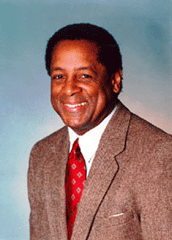
Dr. S. Allen Counter is a Harvard medical school professor, author and adventurer. (Courtesy of S. Allen Counter)
But, turns out Peary’s version of the story is, well, just the tip of the iceberg. Harvard professor and explorer Dr. Allen Counter has devoted decades to filling in the missing chapters. And what Counter’s uncovered is a far more complex picture. For starters, Counter says Peary’s success largely depended on an African American man named Matthew Henson, a crucial member of the polar expedition.
COUNTER: Reaching the North Pole at that time was tantamount to reaching the moon in our lifetimes. No one knew what to expect at the top of the earth, but Peary was a determined man, and he wanted to be the first human being to stand at the top of the earth. You know, later these things came out. But Henson was a man, an African American, who at that time was essentially disenfranchised like most African Americans, and when Peary tried to give an explanation of why he hired Henson, he often said that this was a very intelligent negro man, he was of greater intelligence than most I’ve met, etcetera, and I found in him the abilities that enable him to assist me to get to the pole. Now Henson with equal pride said on the other hand, I met this man Peary, a white man who had the traits and characteristics that made me want to desire to give him my services. So there was pride on both sides.
YOUNG: Did Henson get proper credit or recognition for his contributions?
COUNTER: Well, you ask an interesting and almost I’m sure rhetorical question – it is obvious that none of the people of color, the Inuit people who helped get both of them there nor Henson received any credit. In fact, one general, General Greely, said well, he hasn’t sure Peary made it to the North Pole because all he had for proof was an ignorant Negro and some ignorant Inuit people.
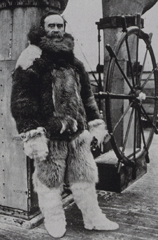
Robert Peary is credited as the first person to set foot on the North Pole (Courtesy of NOAA).
COUNTER: Exactly, they were not – they were called non-credible witnesses. At the same time there was a congressman, I don’t recall his name right away, who wanted to recommend medals for the other men, but he stopped short of doing that because he was afraid he would have to recommend Henson for a medal and he quote “did not want to introduce the name a of a negro on the House floor.” I wonder how we would feel now to see that not only the House floor, but the White House [laughing] has a person of color. So these are the kinds of things that are documented that they faced. Also, the National Geographic gave all sorts of credits and awards and accolades to Peary and totally ignored Henson.
YOUNG: Wow, its just amazing the way that race colored – pardon the pun – the whole enterprise.
COUNTER: Yes. It played a role in every step along the way. And according to the Inuit people, Henson fell asleep on the last part of the dash and Peary tried to wake ‘em up and get them to go ahead without Henson. [laughing] And they wouldn’t do it because they were close to Henson. Henson spoke the language like a native and he persuaded them to go and help them. And so, when they made the final dash Henson took off and was ahead of Peary. And apparently there was an argument. In the 1910 Boston Herald there’s an interview with Henson where he said “Mr. Peary didn’t speak to me all the way back” [laugh] “to the ship.” And when Peary finally arrived he said, “I thought I told you to halt. I gave you an order to halt short of the pole.” And Henson said, “well, I just dashed forward and everything beyond us now is south so we’re both here” or something to that effect. But I’ll bet you Henson probably said to him “Now when you get back to America, you’ll be the all-powerful white leader and you’ll get all the credit. But I want you to know that on this day a colored man from Washington D.C. was the first human being to stand on the pole with these four Inuit men.”
YOUNG: One of the missing chapters if you will here has to do with Henson. But there’s another, and that has to do with the fact that they left behind more than just a flag while they were up there, didn’t they?
COUNTER: [Laughs] Well that’s one way to look at it. Some periods of time during the exploration they were isolated in Greenland, in Northern Canada for up to four years at a time. And they took on virtual Inuit wives. I mean in Peary’s case, he was married, but he had an Inuit wife there as well. And it turns out that Peary fathered two children with her. And Matthew Henson who was not married at the time, Peary’s assistant, had a wife in A La Casina. And she bore him a child. And that child’s name was Anaukaq.

Matthew Henson was an African-American man largely overlooked for his crucial role in exploring the North Pole. (Courtesy of the Library of Congress)
YOUNG: Well, you clearly became very close to these folks and you made a pretty big promise for a special event to mark this anniversary this year. Tell me about that.
COUNTER: Well, you know, when you make promises you have to be careful. Its something I’ve learned with my children.
[LAUGHING]
COUNTER: When you say you’re gonna do something, people expect you to do it. And we started talking with the older sons whom I really came to adore and they were talking about the North Pole and how they would like to go and so forth. But they said, you know, we’re old and we’re going to die soon. And we know that. They were both about 80 at the time. And they said maybe our children will go. And I said I’ll give you my word that when the anniversary of the North Pole discovery comes around in 2009, I’m gonna go there and take children from both sides of the family, the Inuit Peary family and the Inuit Henson.
YOUNG: Go there – you mean to the North Pole.
COUNTER: To the North Pole. I’m going to….
[LAUGHING]
COUNTER: I mean I had no idea how to actually do this. So, you know, you make these promises twenty years ahead. And all of a sudden the time comes around and people are saying basically, what are you going to do. And so I made every effort. I contacted the Air Force and we discussed the prospect. They were very helpful. It was decided that we would take a flight on a C-130, but unfortunately just as I was so enthusiastic about this – I’d notified the family, we’d asked them to select the different family members who would go with us, we were gonna lay a wreath, we were gonna take a time capsule and take a commemorative capsule there and bring it back for young people to learn more about the Artic. Just as we decided to do that, we got the bad news that well, we’ve looked at this and its unlikely we can do this exercise because the ice pack over the ice is so weak, we could not tolerate landing there. And I had heard too that there’d been difficulty with other planes. In fact, I don’t have concrete evidence, but I’ve been told of two instances where planes sank after landing there. So we couldn’t put anybody’s lives at risk. So there I was without a flight. I was able to get the U.S. Navy submarine with the help of Admiral Melvin G. Williams, Jr. were able to get the commemorative case containing memorabilia from Henson and Peary to the North Pole. And we’re very proud of that.
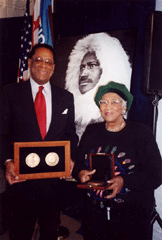
Dr. S. Allen Counter presents the National Geographic Hubbard Gold Medal to Mrs. Audrey Mebane, great-niece of North Pole explorer Matthew Henson (center photo), who earned the award posthumously (Courtesy of S. Allen Counter).
COUNTER: When you start an initiative like this, you cannot predict where it’s going to go, what’s going to happen. Who would have thought that you’d meet a man who just becomes a part of your life. And Afro-Inuit or an Afro-Eskimo who tells you what it means for him to just meet a family member. And it touched my heart very deeply. And become more like family now, not just friends or acquaintances. When they were here in 1987, one of those sons had a pregnant wife. And he said, you know, I’m looking forward to my child and we don’t know what to name him. My mother said to Vittus the grandson of Matthew Henson, she said name him Allen.
[LAUGHING]
COUNTER: And just dropped it like that. So when I got back to Greenland, I must tell you, I was absolutely, just pleasantly shocked to see a six foot five Inuit young man 20 years old, just turning twenty one now named Allen.
[LAUGHING]
COUNTER Allen Henson. I mean it just touched my heart deeply. So not only am I a member of the family, but there’s a young man there named for me and I was just so touched. So, again, that’s why you do it – it’s a human thing. I had no motives other than that from the outset to now.
YOUNG: This is such an amazing story. And it’s on top of what was already and amazing story. Thank you very much for your time. I appreciate it very much.
COUNTER: Thank you very much for having me.
YOUNG: Dr. Allen Counter is a neurology professor at Harvard University and author of "North Pole Legacy: Black, White, and Eskimo."
Counter also helped Matthew Henson get some long overdue recognition: He requested that Henson’s remains be moved to a place of honor—and Henson now lies in Arlington National Cemetery, just next to Robert Peary.
Related link:
S. Allen Counter’s Homepage
Sound Activism

Singer-songwriter Sheryl Crow.
CURWOOD: Musicians have that uncanny knack of letting us feel good about feeling bad…with those songs about love gone wrong…and today to honor the 39th Earth Day we turn to songs about how our relationship with the earth is going wrong…and how we might set it right, starting with a challenge from Sheryl Crow.
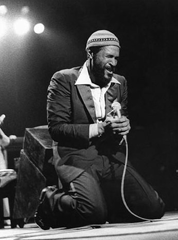
Marvin Gaye.
CURWOOD: Songs about the economic impact of environmental chaos date back to the first Earth Day in 1970 when a hit tune from Marvin Gaye linked the gutters of the ghetto to a globe going awry.
[MUSIC: Marvin Gaye “Mercy, Mercy Me” from What’s Goin On (Motown 1973)]
CURWOOD: Labor, civil rights and eco-activist, Pete Seeger .
[MUSIC: Pete Seeger/Paul Winter Consort “Garbage” from Pete (Living Music 1996)]
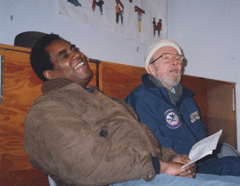
Pete Seeger (right) with Living on Earth host Steve Curwood.
[MUSIC: Counting Crows “Big Yellow Taxi” from Films About Ghosts (The Best Of Counting Crows) (Geffen 2004)]
CURWOOD: While many musicians are environmental activists, few have started their own environmental philanthropies - among them, Rainforest Foundation creator and former lead singer for the Police, Sting.
Seizing on solutions, Sting sings how one earth is enough, if only we are willing to love. Love, he declares, is the seventh wave, and a deeper wave than eco destruction:
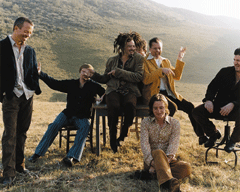
The Counting Crows.
CURWOOD: Our musical tribute to Earth Day and its diverse rhythms is reminder that in each of us our hearts beat in time with the turning of the days. We celebrate the Earth because we love our home and want to keep it livable for all of us and those who follow.
And for this week, that is Living on Earth.
YOUNG: Living on Earth is produced by the World Media Foundation. Our crew includes Bobby Bascomb, Eileen Bolinsky, Bruce Gellerman, Ingrid Lobet, Helen Palmer, Ike Sriskandarajah, and Mitra Taj, with help from Sarah Calkins and Marilyn Govoni.
Special thanks this week to Rachel Gotbaum, who produced our crow story from Auburn, New York.
Our interns are Lindsay Breslau, Liz Gross, Phil DiMartino and Christine Parrish. Jeff Turton is our technical director. Alison Lirish Dean composed our themes.
You can find us anytime at loe.org.
I’m Jeff Young.
CURWOOD: And I’m Steve Curwood. Thanks for listening, and Happy Earth Day.
[MUSIC: Sting “One World (Not Three)/Love Of The Seventh Wave” from Bring On The Night (UMG Records 1987)]
ANNOUNCER: Funding for Living on Earth comes from the National Science Foundation, supporting coverage of emerging science, and Stonyfield Farm: organic yogurt and smoothies. Stonyfield pays its farmers not to use artificial growth hormones on their cows. Details at stonyfield.com.
Support also comes from you our listeners, the Ford Foundation, the Town Creek Foundation, and the Oak Foundation, supporting coverage of climate change and marine issues; The Bill and Melinda Gates Foundation, dedicated to the idea that all people deserve the chance to live a healthy productive life. Information at gates foundation.org; and Pax World Mutual Funds: socially and environmentally sustainable investing. Pax World: for tomorrow. On the web at paxworld.com.
ANNOUNCER: PRI, Public Radio International.
Living on Earth wants to hear from you!
Living on Earth
62 Calef Highway, Suite 212
Lee, NH 03861
Telephone: 617-287-4121
E-mail: comments@loe.org
Newsletter [Click here]
Donate to Living on Earth!
Living on Earth is an independent media program and relies entirely on contributions from listeners and institutions supporting public service. Please donate now to preserve an independent environmental voice.
NewsletterLiving on Earth offers a weekly delivery of the show's rundown to your mailbox. Sign up for our newsletter today!
 Sailors For The Sea: Be the change you want to sea.
Sailors For The Sea: Be the change you want to sea.
 The Grantham Foundation for the Protection of the Environment: Committed to protecting and improving the health of the global environment.
The Grantham Foundation for the Protection of the Environment: Committed to protecting and improving the health of the global environment.
 Contribute to Living on Earth and receive, as our gift to you, an archival print of one of Mark Seth Lender's extraordinary wildlife photographs. Follow the link to see Mark's current collection of photographs.
Contribute to Living on Earth and receive, as our gift to you, an archival print of one of Mark Seth Lender's extraordinary wildlife photographs. Follow the link to see Mark's current collection of photographs.
 Buy a signed copy of Mark Seth Lender's book Smeagull the Seagull & support Living on Earth
Buy a signed copy of Mark Seth Lender's book Smeagull the Seagull & support Living on Earth

